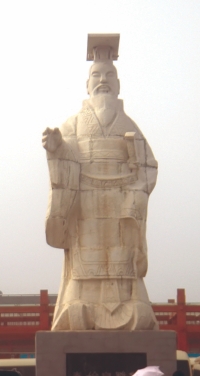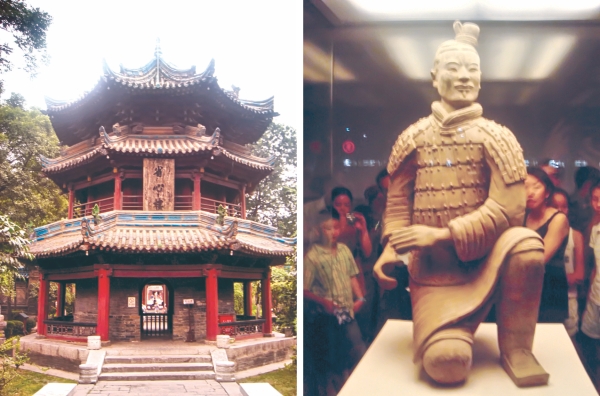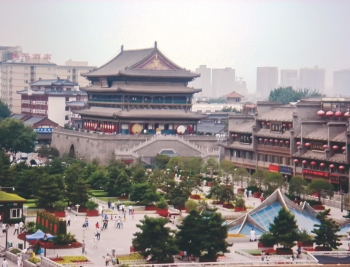| Home - Back Issues - The Team - Contact Us |
 |
| Volume 10 |Issue 35 | September 16, 2011 | |
|
|
Travel At the Gateway of the Silk Road Mehdi Musharraf Bhuiyan
Talking of history and its ever changing course, Ralph Hodgson once compared time with an 'Old Gypsy Man' who would never halt his caravan for a day for the lure of all the gifts in the world. “Iram indeed is gone with all its rose” sang Omar Khayyam while talking of the perishability of worldly pomp. “But still the vine her ancient ruby yields…” he said next while talking of the perpetuity of eternal human legacy and spirit compared to their more grandiose counterparts. Gazing through the hazy outsight of my airline window, this was my immediate feeling after having the first glimpse of the city of Xi'an as the tiny airliner rushed through the runway of the Xianyang airport while I tried to reconcile my passion for a further voyage into China's interior after days of intense expedition. This was the hottest time of the year and a dusty wind supposedly blowing from the steppes of central Asia greeted me with a dried but charming warmth. The city, in its first glimpse is nothing out of ordinary when compared to its more pompous Chinese counterparts. Rather, to an average onlooker, the town may seem a bit pale and mundane comparing to the more bustling cityscapes of coastal China. But browse through the pages of history and you will find that 'Time the old Gypsy Man' did tighten his rein beneath its old city walls and towers more than once- and the city has had its day under the sun. Go back a thousand years in time—and this was the ultimate megalopolis of the world where the famed journeys of the 'Silk Road' used to begin. Back in the golden days of overland trade, Chang'an as it was known in those days, was the capital of China's most acclaimed dynasties and the ultimate cultural melting pot of the ancient Middle Kingdom. Nestled by the rivers of ancient north Chinese plain, the province of Shaanxi and the surrounding areas have been the cradle of Chinese civilisation for thousands of years. The area's locational advantage prompted many Chinese conquerors to turn it into their home ground along their expansion across the plains of the Yellow River.
Chang'an- meaning 'Perpetual Peace' in Mandarin, has thus seen the rise of fall of many of the 'Pax Cinica's for two millennia, resulting in the city becoming the focal point of ancient Chinese economy and culture until its eventual downfall around the end of the first millennium- which was shortly followed by the eventual adaption of the location around present day Beijing as the nation's capital by the subsequent dynasties including the Mongol and the Ming Empire. In the glory days of the Silk Road, the city was a thriving global metropolis of two million- where cultures of the ancient and medieval world came to meet. Tea, silk and porcelain used to find their way to the countries to the west while gold, ivory and glass, which was not native to the Middle Kingdom was brought from lands afar. For any history buff; the name of Xi'an is probably first and foremost identical with the Mausoleum of Qin Shi Huang-- China's very own 'Pyramid of Giza'; which is better known as the Mausoleum of the Terracotta Warriors. To make a long story short, the mausoleum was built as a final resting place for an Emperor named Qin Shi Huang who is credited with unifying China by rapid conquests two hundred years before Christ (and after whom, the country is supposedly name). As was the case with many rulers of that era- Emperor Qin Shi Huang, during his lifetime, ordered a large mausoleum to be built along the line of his numerous royal palaces with a view to accommodate all the supposed comfort and protection he might require in the after life. Feast is after all followed by a famine- and it was not long before the all conquering monarch found his way to his treasured burial chamber. And when that moment came, the deceased emperor, according to the custom of that time, was not to go alone to his burial mansion, but to be accompanied by his palace servants and officials to escort him forever in the afterlife. The 8,000 earthen soldiers whose images later came to iconise the place were supposed to guard the sovereign in the afterworld. Nevertheless, the whereabouts of this whole mega arrangement was unknown to the modern world until they were eventually discovered by a group of local farmers in 1974.
Today, the mausoleum is an extended compound featuring several original pits as well as a museum housed within modern architecture which showcases hundreds of earthen terracotta soldiers standing ground in columns; protecting the necropolis from the supposed invaders for which they have been waiting for 2000 years. The actual tomb of the emperor, situated some hundred metres away from the present tourist site, is said to have never been opened for the sake of the preservation of valuable artifacts. Spending hours at the Qin Shi Huang Mausoleum however; not for a single moment, waned my personal disdain for the man to whom this mass burial site is devoted. Qin Shi Huang, for all his greatness as a supposed unifier of China- was also a notorious tyrant- who aimed to suppress all the ideas of his time by ordering all the books to be burnt and scholars to be buried alive- and to me, the construction of this colossal burial chamber just for the sake of his afterlife was an expression of the man's desperate arrogance and despotism. Millenniums have passed since the archers and chariots of Qin Shi Huang rumbled the Earth, and yet that despotic spirit of politics around the world has not diminished for a bit over the years. Whenever a new political group with a certain interest, ideology or creed takes hold in a society, one of their first jobs would be to develop a vogue personality cult around their central figures while demonizing their opponents and erasing the legacy of the former. Now back to the modern day Xi'an, the city is something in between the typical Chinese suburbs and its more bustling mega cities. The sign of recent Chinese prosperity and economic growth is quite apparent through the ordinary eyes in the visible construction boom and the bustling automobiles honking through the streets of the provincial capital. Nevertheless, the sign of the developing world still lingers in some older parts of the metropolitan. The city's Muslim Quarter is reminiscent of China's Arab connection dating back to the days of the Silk Road. Strolling down the streets in the quarter, visitors would find locals wearing identical Islamic head gear- a symbol of their well preserved identity, while the shops and restaurants here vend special Iftar items during the month of Ramadan. One of China's oldest mosques, (and also one of the world's oldest) is located in the Muslim Quarter of the city- which is more well known as the Great Mosque of Xi'an, and is said to be established in as early as the eighth century. The mosque is unique in that it has followed the traditional Chinese architectural style in its appearance while maintaining the basic ingredients of a Muslim prayer hall- giving it an additional flair of green and serenity stereotypical of a Chinese garden house. Ideas met along with goods through the Silk Road- as not only Islam but also Buddhist ideas were exchanged through its gateway. The Giant Wild Goose Pagoda, another 1300 years old land mark of Xi'an bears the memory of Xuan Zang, who spent 18 years in India studying Buddhism and on his return, brought numerous Sanskrit manuscripts to be translated into Mandarin. Past is present in Xi'an's cultural milieu, as manifested by the state-of-the-art performance of its professional cultural theatres- which is still preserving and popularising the 1500 years old court music and dance performances of the old dynasties. The city's residents apparently put high emphasis on education- as this city of eight millions hosts a total of 52 institutions of higher education and the proportion of technical personnel in Xi'an is said to be the highest in China. In recent years, Xi'an has also become a leader in aeronautics, aerospace, software, and other high value industries. Although, obscured in prominence by its younger counterparts like Beijing and Shanghai, the city and its residents nevertheless have retained their former sense of pride; as evident from a local resident who put it to me this way, “If you want to know ten years of China, go to Shanghai; if you want to know hundred years of China, go to Beijing; but if you want to know thousand years China, come to Xi'an”. But beyond these cultural and economic hotspots, what struck me most was the broader city scape which is unique and exquisite in its touch of Chinese style architecture. Tall, lofty skyscrapers are aplenty here, like any world class urban centres- but their topmost is essentially dominated by ancient style Chinese style 'dougong' rooftops and spires. At the centre of the modern Xi'an metropolis is the ancient landmarks of Bell Tower, Drum Tower and the City Wall, dating back from the Ming Dynasty- surrounding which the modern metropolis and the downtown has developed. As if, the city has graciously embraced modernity while proudly holding onto its past glory in the cuddle. Having been earlier to all the big cities of the PRC, including the commercial hub of Shanghai and the modern day capital of Beijing, it seems to me that no other present cities of China has retained more of a true Chinese feeling and aura in its appearance as Xi'an. Iram may indeed be gone– along with Jamshyd's sev'n-ring'd cup to a place unknown (Khayyam). But Xi'an- in line with its ancient name of Chang'an, has really retained the perpetual peace and glory that comes with the grandeur and memory of thousands of years. The writer is a former journalist and currently working for the United Nations.
Copyright
(R) thedailystar.net 2011 |
||||||||


